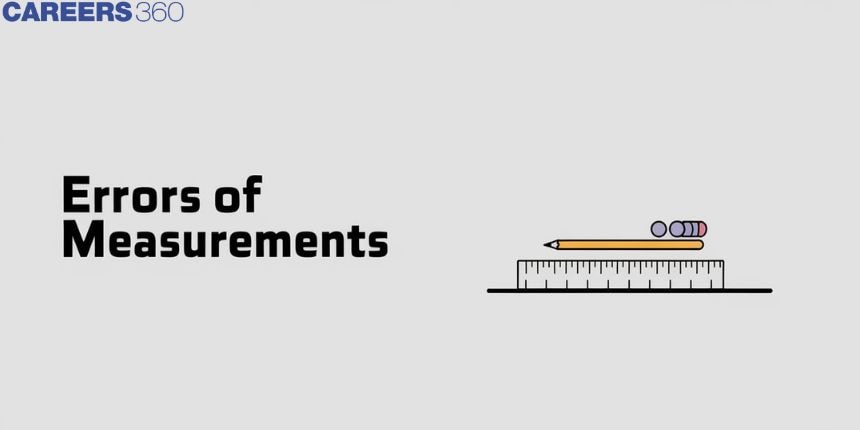Errors Of Measurements
Measurement errors may be part of the ease of execution or lead to inaccurate results with scientific conclusions and industrial processes. Practically it is very important to know the sources and types of measurement errors in real-world situations in order to assure the data quality or make any decision based on measurements.

In this article, we will cover the concept of Errors Of Measurements. This concept is part of the chapter Physics and Measurement, which is a key chapter in Class 11 physics. It is crucial for board exams and competitive exams like the Joint Entrance Examination (JEE Main), National Eligibility Entrance Test (NEET), and other entrance exams such as SRMJEE, BITSAT, WBJEE, VITEEE, among others.
Over the last decade, one question related to this concept was asked in the JEE Main exam (2013-2023). In the NEET exam, four questions from this topic were featured in the same period.
Errors of Measurements
It is the magnitude of the difference between the true value and the measured value of the quantity.
It may be positive in certain cases and negative in certain other cases
If a1,a2,a3………an are a measured value then
am=a1+a2+……ann
where am = true value
then
1)Absolute Error for nth reading =Δan=am−an= true value - measured value
So Δa1=am−a1Δa2=am−a2
2) Mean absolute error
Δa¯=|Δa1|+|Δa2|+….|Δan|n
3) Relative error or Fractional error
The ratio of mean absolute error to the mean value of the quantity measured.
Relative error =Δa¯amΔa¯− meanabsolute error am= mean value
4) Percentage error
Percentage error =Δa¯am×100
Error in sum and Error in difference of two physical quantities
1) Error in sum (x=a+b)
- Error in sum ( x=a+b) :-
- absolute error in x=Δx=±(Δa+Δb)
where
Δa= absolute error in measurement of a
Δb= absolute error in measurement of b
Δx= absolute error in measurement of x
- The percentage error in the value of x=
Δxx×100=(Δa+Δb)a+b×100
2) Error in difference ( x=a−b )
- Absolute error in x=Δx=±(Δa+Δb)
- Percentage error in the value of x=
Δxx×100=(Δa+Δb)a−b×100
Error in product and Error in division of two physical quantities
1) Error in product x=ab
- maximum fractional error= Δxx=±(Δaa+Δbb)
where
Δa= absolute error in measurement of a
Δb= absolute error in measurement of b
Δx= absolute error in measurement of x
- The percentage error in the value of x=
Δxx∗100=±(Δaa∗100+Δbb∗100)
=(% error in value of a+% error in value
of b)
2) Error in division
x=ab
- maximum fractional error in x=Δxx=±(Δaa+Δbb)
- The percentage error in the value of x=
Δxx∗100=±(Δaa∗100+Δbb∗100)
=(% error in value of a+% error in value of b)
Error in Quantity Raised to Some Power
when (x=anbm)
- The maximum fractional error in x is:-
Δxx=±(nΔaa+mΔbb)
- Percentage error in the value of x==
Δxx∗100=±(nΔaa∗100+mΔbb∗100)
Solved Example Based On Errors Of Measurements
Example 1: The value of the absolute error of the first measurement in a measured value a1,a2..............am is equal to [am is the true value]
1) a1+a2…ann
2) |am−a1|
3) a1am
4) a1∗am
Solution:
Errors of measurements -
If a1,a2,a3………an are a measured value
then am=a1+a2+……ann
where am= true value
Absolute Error for nth reading =Δan=am−an= true value - measured value
The absolute error of the first measurement, n=1
Δa1=am−a1
Hence, the answer is option (2).
Example 2: In the measurement of the period of a simple pendulum, the readings turn out to be (1) 2.63 s (2) 2.56 s (3) 2.42 s (4) 2.71 s (5) 2.80 s. Calculate the % error in the measurement.
1) ±4
2) ±3
3) ±5
4) ±2
Solution:
As we have learned
percentage error =ΔTmTm×100%
Maen value of time period-
Tm=2.63+2.56+2.42+2.71+2.805=2.624
Tm≈2.62
Absolute error:
ΔT1=2.62−2.63=−0.01s
ΔT2=2.62−2.56=+0.06s
ΔT3=2.62−2.42=+0.20s
ΔT4=2.62−2.71=−0.09s
ΔT5=2.62−2.80=−0.18s
Mean absolute error,
Mean absolute error, ΔTm=∑|ΔTn|n=0.545=0.11 s so, percentage error =±ΔTmTm×100=±0.112.62×100≈±4%
Hence, the answer is the option (1).
Example 3 The resistance R=V1, where V=(50±2)V and I=(20±0.2)A. The percentage error in R is x%. The value of ' x ' to the nearest integer is
1) 5
2) 10
3) 15
4) 20
Solution:
% error in R=ΔRR×100ΔRR×100=ΔVV×100+ΔI1×100⇒ΔRR×100=250×100+2220×100=4+1=5⇒% error in R=5%
Hence, the answer is the option (1).
Example 4: If a tuning fork of frequency (f0)340 Hz, tolerance ±1∘% is used in the resonance column method [v=2f0(l2−l1)], the first and the second resonances are measured at The max. permissible error in speed of sound is :
1) 1.4∘/o
2) 1.8∘/o
3) 1%
4) 0.8%
Solution:
Error in division x=a/b -
Δxx=±(Δaa+Δbb)
( maximum fractional error in x )
- wherein
Δa= absolute error in measurement of a
Δb= absolute error in measurement of b
Δx= absolute error in measurement of x
[Δvv]max=Δf0f0+Δl1+Δl2l2−l1=1100+0.1+0.174−24=[1100+0.250]×100∘/o=1.4∘%Hence, the answer is the option (1),
Example 5:The unit of percentage error is
1) Same as that of the physical quantity
2) percentage error is unitless
3) the error will have its own unit
4) square that of a physical quantity
Solution:
As we know percentage error is the ratio of two similar kinds of physical quantities.
Percentage error =Δa¯am×100%
So, the Percentage error is unitless.
Hence,the answer is option (2).
Summary
This article explains the concept of measurement errors, their types, and their significance in ensuring data quality. It provides formulas for calculating absolute, mean absolute, relative, and percentage errors, along with solved examples to illustrate these calculations. This topic is crucial for various academic and competitive exams in physics.